5 Best Muzzleloader Scopes in 2024 – Reviews & Top Picks
Last Updated on
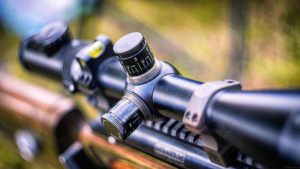
Muzzleloader shooting is an excellent pastime whether for fun or hunting, traditional or modern. For a serious marksman, especially modern, and especially a hunter looking for a trophy or food on the table, optics are indispensable. Optics instantly improve a hunter’s ability to hit smaller targets at greater distance. They also make the target easier to see and, in some cases, collect more light than the naked human eye, improving dawn and dusk shooting accuracy. Here is a list of scopes we’ve reviewed that are particularly useful in muzzle-loading black powder guns.

A Quick Look at Our Favorites (2024)
| Image | Product | Details | ||
|---|---|---|---|---|
| Best Overall |
 |
Burris Scope Fullfield 3-9x40mm E1 Ballistic Plex Muzzleloader |
|
CHECK PRICE |
| Best Value |
 |
Hawke Sport Optics Vantage 3-9x40mm Rifle Scope |
|
CHECK PRICE |
| Premium Choice |
 |
Leupold VX-Freedom 3-9x40mm Rifle Scope with Ultimate Slam Reticle |
|
CHECK PRICE |
 |
Huskemaw Blue Diamond 5-20x50mm Rifle Scope |
|
CHECK PRICE | |
 |
Vortex Crossfire II 3-9x40mm Rifle Scope |
|
CHECK PRICE |
The 5 Best Muzzleloader Scopes
1. Burris Scope Fullfield 3-9x40mm E1 Ballistic Plex Muzzleloader – Best Overall
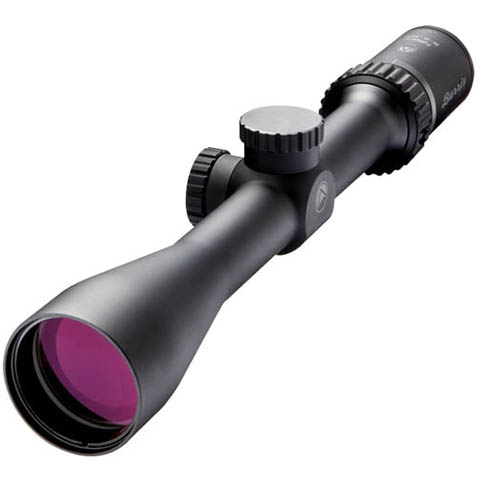
| Magnification: | 3–9x |
| Objective Lens Diameter: | 40mm |
| Reticle Type: | Plex |
| Focal Plane Type: | SFP |
Burris has an outstanding reputation for high-quality, well-priced optics, and our choice for best overall muzzleloader scope is no exception. The Burris Scope Fullfield 3-9x40mm E1 Ballistic Plex Muzzleloader scope is a no-frills scope with a bullet-drop compensating plex crosshair. 3–9x magnification is perfect or even overkill for most muzzleloading-ranged hunting, and a 40mm objective lens captures enough light for shooting even in dusk and dawn conditions.
- Reasonable price
- Bullet-drop compensation reticle
- Sturdy and reliable
- Non-illuminated
- Relatively heavy at 13oz
- Second focal plane
2. Hawke Sport Optics Vantage 3-9x40mm Rifle Scope – Best Value
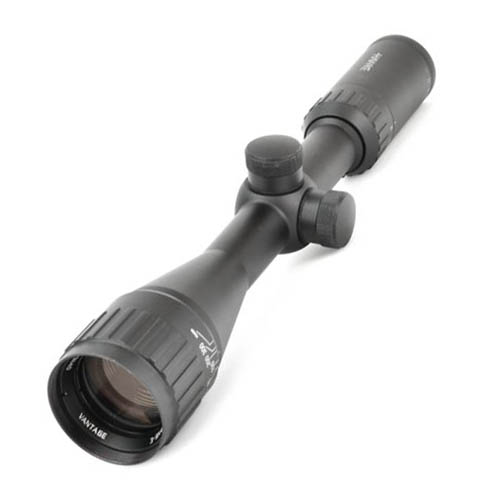
| Magnification: | 3–9x |
| Objective Lens Diameter: | 40mm |
| Reticle Type: | MILDOT |
| Focal Plane Type: | SFP |
Hawke optics are known for crystal clear glass at an affordable price. This Hawke Sport Optics Vantage 3-9x40mm Rifle Scope has the same magnification and objective lens diameter as our best overall choice but is a “best for the money” fit. Some reviewers have experienced reliability problems with Hawke optics. This reviewer has owned Hawke optics for several years alongside Burris, Redfield, Leupold, Nikon, and others, and never had issues with any of them. This particular scope is ideal for the ranges used in shooting muzzleloaders.
- Very clear optics
- Affordable Price
- Waterproof
- May not be built as sturdily as higher-priced optics
- SFP
3. Leupold VX-Freedom Rifle Scope with Ultimate Slam Reticle – Premium Choice
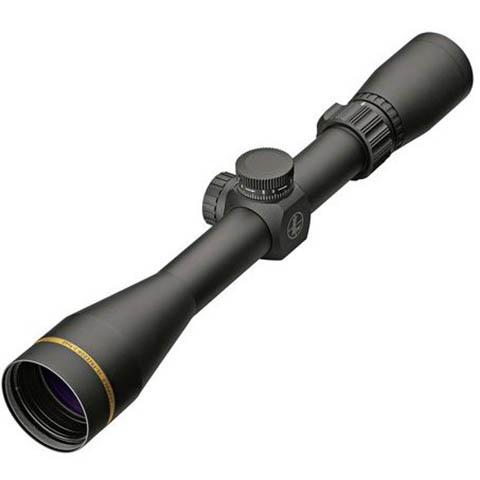
| Magnification: | 3–9x |
| Objective Lens Diameter: | 40mm |
| Reticle Type: | Proprietary Leupold “UltimateSlam” BDC Reticle |
| Focal Plane Type: | SFP |
Leupold is the premium choice for optics. Their scopes are legendary for maintaining zero even after being dropped or knocked around with other hunting gear. This Leupold VX-Freedom 3-9x40mm Rifle Scope offers the same magnification and objective lens diameter as our best overall choice and budget choice scopes – 3–9x40mm, perfect for muzzleloaders. This scope comes with 3 different crosshairs, including Plex, CDS Tri-MOA, and UltimateSlam. The UltimateSlam hunting reticle is designed specifically for hunting at ranges that favor muzzleloading rifles, both for quick target acquisition and estimating bullet drop at further distances.
- Made by one of the greatest optics manufacturers of all time
- Fantastic optics quality
- Reticle is designed specifically for hunting game
- SFP
- Expensive
4. Huskemaw Blue Diamond 5-20x50mm Rifle Scope

| Magnification: | 5–20x |
| Objective Lens Diameter: | 50mm |
| Reticle Type: | Huntsmart |
| Focal Plane Type: | SFP |
The Huskemaw Blue Diamond 5-20x50mm Rifle Scope is designed specifically for long-range hunting. Many hunters don’t think of muzzleloaders when hunting game beyond 300 yards, but the 14th longest sniper kill in history (1390 yards) was made with a muzzle-loading Whitworth rifle during the American War Between the States. To make shots at such ranges requires high-end rifles and is made much easier with high-end optics. This scope is just over the general lowest magnification required for 1000-yard shots (18x) and has several features that make it ideal for long-range shooting, including an especially designed reticle and precise adjustable zero stop. A hunter can also order a custom turret for adjustments made specifically for their rifle, caliber, and other customization options.
- Very sturdy
- Customizable turret with adjustable zero stop
- 20x zoom and 50mm objective lens are ideal for long-range hunting
- Zoom only adjusts down to 8x, which is too high for close hunts
- Expensive
5. Vortex Crossfire II 3-9x40mm Rifle Scope
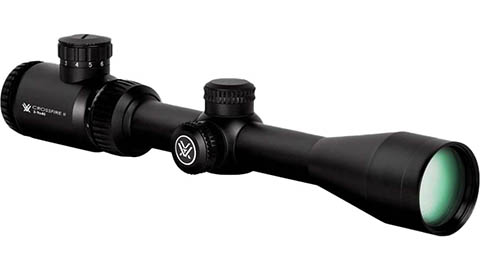
| Magnification: | 3–9x |
| Objective Lens Diameter: | 40mm |
| Reticle Type: | Proprietary V-Brite Plex Reticle |
| Focal Plane Type: | SFP |
Vortex is known for making scopes with excellent optical quality and sturdiness, and their warranty is one of the best in the industry. The Vortex Crossfire II 3-9x40mm Rifle Scope scope is very like the first few on the list (3–9x40mm) with one special exception: It has an illuminated reticle. For hunters with fading eyesight or who prefer dusk or dawn hunting, an illuminated reticle is a game-changer. No more hunting for the crosshairs against grey-lit bushes or dark brown leaf patches! Instead, an adjustable red glow will make it easy to find the crosshairs and place them over the target.
- Illuminated reticle
- Relatively low cost
- SFP

Buyer’s Guide: How to Pick the Best Scope for Your Muzzleloader
What is the difference between black powder rifle scopes and regular rifle scopes?
Blackpowder rifle scopes must be able to handle relatively heavy recoil for the range of the round fired. Blackpowder bullets tend to be larger caliber and heavier. That’s why the “best” selected scope is specifically built for blackpowder use.
Is there a downside to using a scope on a blackpowder rifle?
Yes. The “spent” gunpowder from a blackpowder muzzleloader is much more corrosive than smokeless powder from a brass cartridge. This can not only put more wear and tear on the finish of the gun itself but also the scope. Some experts like Chuck Hawks recommend buying special covers or using cheap electrical tape on the scope to protect it from this corrosion. At the very least, it is important to clean the rifle and the scope thoroughly after each shooting session and may be prudent to give it a wipe in the field. A wipe cloth can be as simple as a shop rag lightly sprayed with RemOil and kept in a plastic baggy in a shirt pocket.
What is the best magnification for a muzzleloader scope?
For most hunters, muzzleloaders are a way to take advantage of extended hunting seasons in many states. The anticipated range is around 300 yards, making a 3–9x scope with at least a 40mm objective lens ideal. 3x is excellent for close-range shooting. 5x magnification is considered ideal for 500–600-yard range. 40mm collects enough light to be used in overcast or dusk/dawn shooting environments.
For those enthusiasts who prefer to shoot/hunt at extreme ranges with a muzzleloader, a scope capable of at least 18x for 800+yards is ideal, and a 50mm objective lens becomes important to ensure enough light enters the scope for clear visibility in lower-light conditions. These scopes are usually much more expensive, particularly when built robust enough to handle a long-range muzzle-loading rifle’s recoil.
What should I look for in a muzzleloader scope?
Sturdiness. Muzzleloading rifles have tremendous recoil for their usual range when compared to smokeless cartridges. Cheaper scopes that can survive on a .270 bolt-action may be destroyed on a .45 black powder rifle.
What is the best reticle in a muzzleloader scope?
This depends on use. For shorter ranges, a classical plex-style reticle is ideal, or one of the dedicated hunting reticles like Leupold’s UltimateSlam or Nikon’s BDC are excellent reticle choices.
For shooting beyond 500 yards, it is ideal to have an MOA or more detailed BDC compensating reticle. If windage is a concern, then the reticle should be constructed to help account for it – the Huskemaw scope listed above has a great example in their proprietary Huntsmart reticle design.

Conclusion
When choosing a scope for a muzzle-loading rifle, it’s important to consider the range the rifle will be used at, build quality, and whether an illuminated reticle is an important choice. In our reviews, the Burris Scope Fullfield 3-9x40mm E1 Ballistic Plex Muzzleloader was the clear winner – specifically designed for muzzle-loaders and made by one of the most trusted names in the optics industry. The Hawke Sport Optics Vantage offers similar magnification at a lower cost, and the Leupold VX-Freedom with the Ultimate Slam Reticle puts a scope that is second to none in this price range for quality on your rifle.
Featured Image Credit: robbrownaustralia, Pixabay
Table of Contents
- A Quick Look at Our Favorites (2024)
- The 5 Best Muzzleloader Scopes
- 1. Burris Scope Fullfield 3-9x40mm E1 Ballistic Plex Muzzleloader – Best Overall
- 2. Hawke Sport Optics Vantage 3-9x40mm Rifle Scope – Best Value
- 3. Leupold VX-Freedom Rifle Scope with Ultimate Slam Reticle – Premium Choice
- 4. Huskemaw Blue Diamond 5-20x50mm Rifle Scope
- 5. Vortex Crossfire II 3-9x40mm Rifle Scope
- Buyer’s Guide: How to Pick the Best Scope for Your Muzzleloader
- Conclusion
About the Author James Davis
James Davis is a pharmacist, husband, father, homesteader, jack-of-all-trades, and freelance writer. He’s always looking for new ways to make useful knowledge accessible to everyone wanting a better life. Let's learn from what he has to share!
Related Articles:
How to Clean a Refractor Telescope: Step-by-Step Guide
How to Clean a Telescope Eyepiece: Step-by-Step Guide
How to Clean a Rifle Scope: 8 Expert Tips
Monocular vs Telescope: Differences Explained (With Pictures)
What Is a Monocular Used For? 8 Common Functions
How to Clean a Telescope Mirror: 8 Expert Tips
Brightfield vs Phase Contrast Microscopy: The Differences Explained
SkyCamHD Drone Review: Pros, Cons, FAQ, & Verdict



